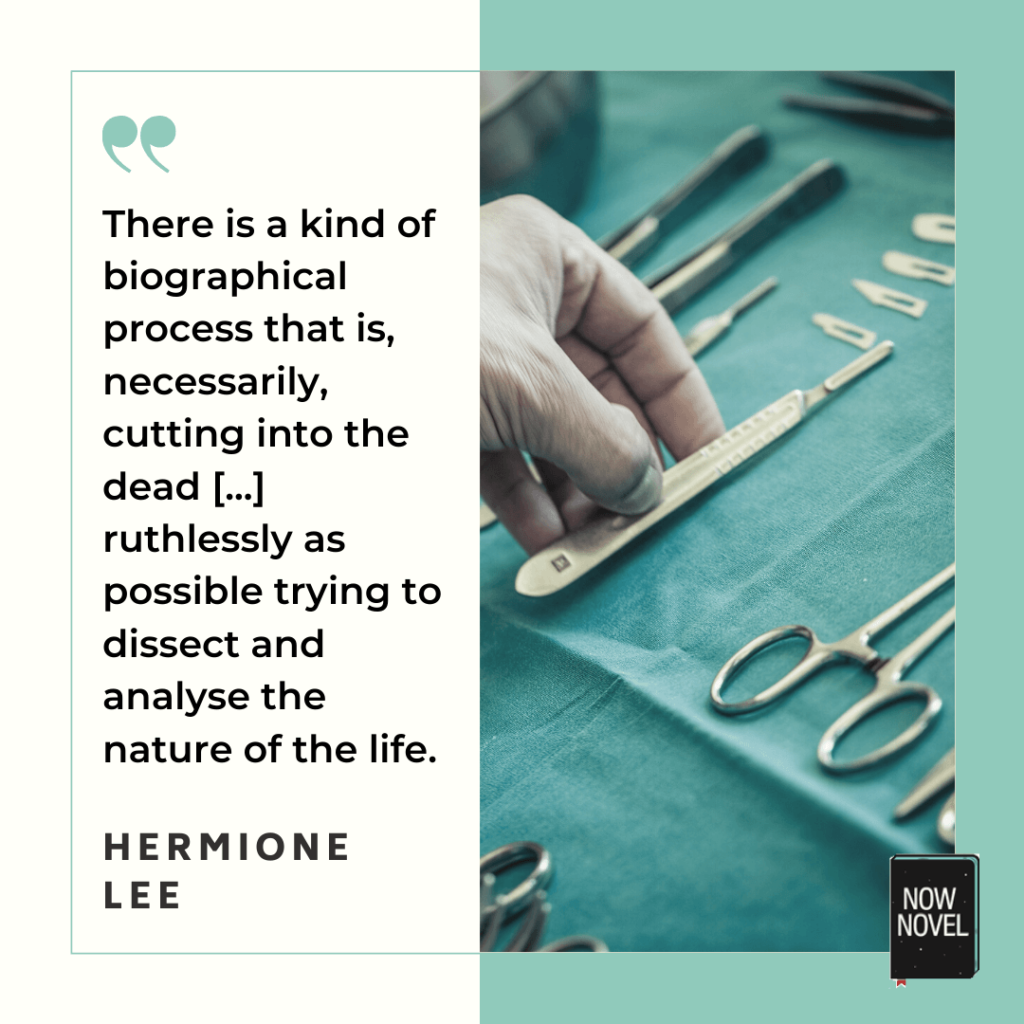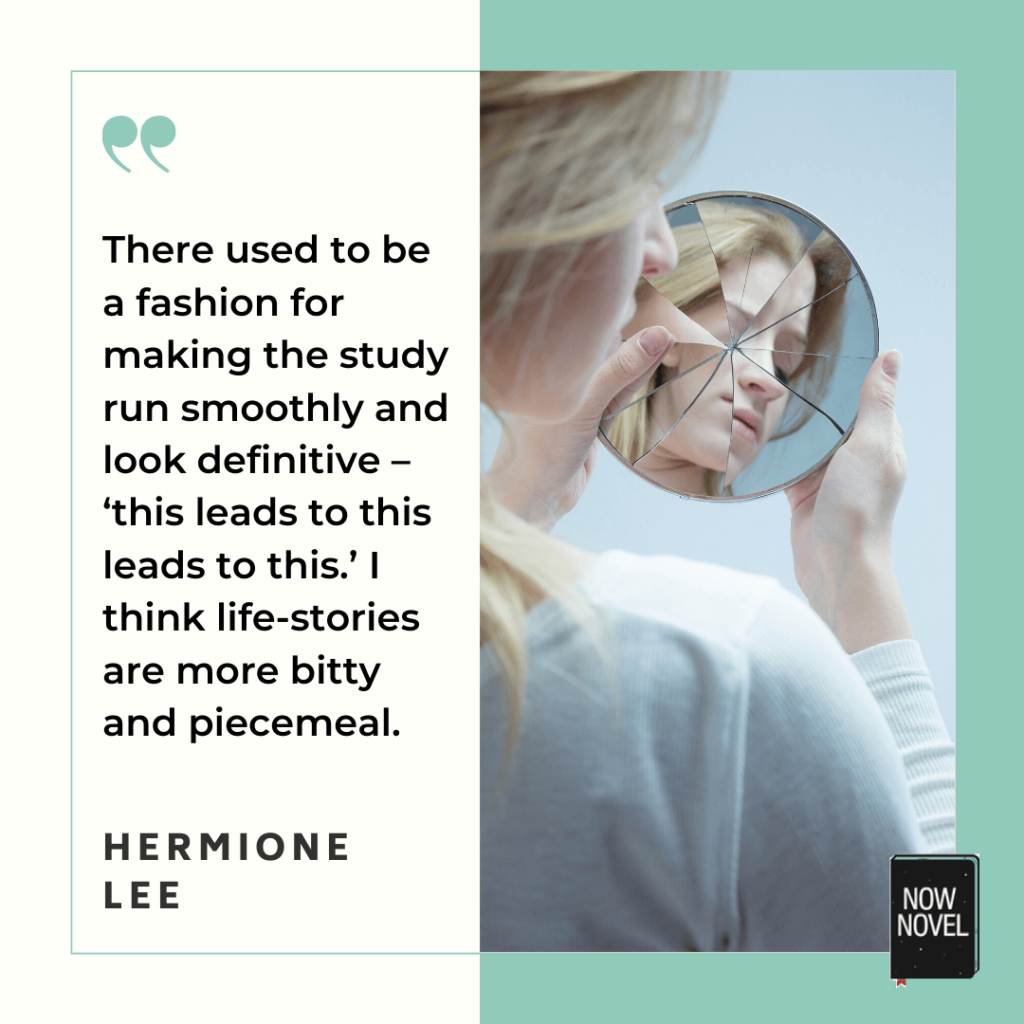Biography – literally ‘life writing’ – poses a variety of challenges. Balancing historical narration and day-to-day incident, for example. Or choosing what to include and what to leave out. Read 7 ideas on how to write a biography, with examples from biographical writing:
7 life-writing ideas:
- Create compelling voice
- Think about representation
- Decide on narrative style
- Use illustrative anecdotes
- Find interest in the mundane
- Avoid hagiography
- Fictionalize where necessary
First: What type of biography do you want to write?
There are many different types of biography, both in fiction and non-fiction.
Popular types of biographical books
If you want to write non-fiction, you may be working on either an autobiography (a book about your life) or memoir, or a biography of a public figure.
Biographies can straddle both fiction and non-fiction, too. Many authors have written semi-fictionalized biographical stories (such as Now Novel writing coach Hedi Lampert’s novel, The Trouble with My Aunt) with the author themselves as a main or supporting character.
For example, in Ivan Vladislavic’s Portrait with Keys, the author invents a brother. This fictional addition allows for lively debates between him and this imaginary relative about urban spaces and race politics in the city of Johannesburg.
Novelized biographies (such as Charles Dickens’ David Copperfield or Charlotte Brontë’s Jane Eyre) often follow a central character’s life arc in a linear way, from early life to later years or even death.
Other types of fictional biography include fictional letters and diaries. These allow you to play with other modes of representation.
For example, Sue Townsend’s popular Adrian Mole series (the first book being The Secret Diary of Adrian Mole, Aged 13¾), presented as a British teenage boy’s diary.
Let’s examine 7 ideas about how to write a biography:
1. Create compelling voice
You could say that voice is a crucial ingredient of any story, especially in first person (where the narrator is the character).
In autobiography, in particular, you want your reader to form a clear sense of who is telling the story. Are they funny? Serious? Angry? Inventive? Philosophical? Just a little bit insane?
Consider the comical, self-aware voice that comes through from page 1 of Townsend’s novel. The first chapter, under the heading ‘THURSDAY JANUARY 1ST’, begins:
These are my New Year’s resolutions:
1. I will help the blind across the road.
Sue Townsend, The Secret Diary of Adrian Mole, Aged 13¾ (1982), p. 5.
2. I will hang my trousers up.
3. I will put the sleeves back on my records.
4. I will not start smoking.
5. I will stop squeezing my spots.
6. I will be kind to the dog.
7. I will help the poor and ignorant.
8. After hearing the disgusting noises from downstairs last night, I have also vowed never to drink alcohol.
Adrian Mole’s resolutions range from the virtuous to the droll (e.g. helping the ‘poor and ignorant’; scathing remarks on his parents’ drunken ‘disgusting noises’).
From the opening page there’s a clear sense of the voice of the subject of this diary-format biography. We form a sense of Mole’s desires, faults, attitudes and beliefs straight away.
2. Think about representation
Whether you’re writing fictional or non-fictional biography, how you represent events or tell the story is a creative decision.
Besides curating content (choosing what formative experiences, dramatic incidents, background details you include), there are different ways to approach representation, the way you tell the story.
As respected literary biographer Hermione Lee says, in an interview with James Rivington, there’s a difference between ‘autopsy’ and ‘portraiture’:
Autopsy, yes. There is a kind of biographical process that is, necessarily, cutting into the dead corpse, however ghoulish that can seem. You are as ruthlessly as possible trying to dissect and analyse the nature of the life.
The other approach is more akin to portraiture: to see how the person looked from the outside, how they affected and influenced people, what their friendships were like, how they were one thing to one person and another thing to another person. I think you have get at both inside and outside if you can.
Hermione Lee, interviewed by James Rivington for The British Academy
What Lee touches on is the issue of representation.
How will you mix biographical and historical facts (e.g. born here, raised there, had this key experience) with more painterly ways of revealing character?

3. Decide on narrative style
Deciding how to write a biography means choosing between many available narrative modes or styles.
Will your story run from A to B to C, documenting each decade in a person’s life? Or will it be a crisscross portrait cutting back and forth in time?
A fragmentary style of narration may suit certain subjects and contexts better than a linear story. Says Lee:
I think that biography has to be watchful of making life seem too predictable, or determinist, or shaped, or ordered. Biographies go through fashions. There used to be a fashion for making the study run smoothly and look definitive – ‘this leads to this leads to this.’ I think life-stories are more bitty and piecemeal.
Hermione Lee, interview for The British Academy
Example of inventive narrative style: Roland Barthes
As an example, Roland Barthes, a pioneer in semiotics (the study of signs and symbols and their interpretation), famously wrote an autobiography in fragments called Roland Barthes by Roland Barthes.
In this book, Barthes includes the preface ‘it must all be considered as if spoken by a character in a novel’.
What follows are captioned images from Barthes’ life, and then titled fragments where Barthes reflects on incidents, places, experiences and the development of his body of work.
For example, in a short section about the discomfort of writing called ‘Truth and Assertion’, Barthes refers to himself in third person, expressing discomfort in how words committed to paper express more than our original aims:
His (sometimes acute) discomfort—mounting some evenings,
Roland Barthes, Roland Barthes by Roland Barthes, p. 48, available here.
after writing the whole day, to a kind of fear—was generated by his
sense of producing a double discourse, whose mode overreached its
aim, somehow: for the aim of his discourse is not truth, and yet this
discourse is assertive.
(This kind of embarrassment started, for him, very early; he
strives to master it — for otherwise he would have to stop writing —
by reminding himself that it is language which is assertive, not he).
Fragments provide a fitting choice of narrative style for an unconventional autobiography that is as much a self-portrait of Barthes as a questioner of seemingly self-evident truths, as it is the representation of his life.
Barthes’ use of third-person and questioning reflections on the act of writing creates the ‘looking from the outside’ effect Hermione Lee describes as ‘portraiture’ in biography. Even as Barthes creates a self-portrait, he resists the idea of the ‘assertive’ author, the ‘completeness’ of the ‘final report’.
4. Use illustrative anecdotes
An English professor once asked his third year class ‘What is an anecdote?’
A girl put up her hand and answered, ‘It’s what you give someone when they’ve been bitten by a snake’, to which he replied ‘Please don’t ask someone for an anecdote if you’re ever bitten by a snake, for they will talk and talk and you will die.’
This is an anecdote. These usually short, often humorous stories about events involving a particular person are great fodder for biographies. They may illustrate a person’s quick wit or surly, non-communicative demeanor.
In biography, a brief anecdote may be all the reader needs to develop a sense of a key figure – a parent, friend, lover, rival or other.
Example of illustrative anecdotes: Dorothy Parker
The writer, poet and satirist Dorothy Parker is known for her witty comebacks and phrases.
One anecdote illustrating this character gives an alleged exchange between Parker and a snooty woman at an event, where both were trying to enter through a door at the same time:
It is recorded that Mrs. Parker and a snooty debutante were both going in to supper at a party: the debutante made elaborate way, saying sweetly “Age before beauty, Mrs. Parker.”
Dorothy Parker, attributed. More on this anecdote at Quote Investigator.
“And pearls before swine,” said Mrs. Parker, sweeping in.
Parker’s clever comeback to the woman’s quip about her being the older (and the implication she is less beautiful) evokes Jesus’s sermon on the Mount in which he said ‘Do not give what is holy to the dogs; nor cast your pearls before swine…’
The anecdote is a brilliant illustration of Parker as a quick-witted person with a sharp tongue and an ear for comedy. An anecdotal exchange here conveys a good sense of personality.
5. Find interest in the mundane
When we think about how a biography is written, we might think in terms of grand, important or scandalous events. Yet a biography is not a gossip column.
Lee makes this important point in her interview, regarding Virginia Woolf’s eventual suicide.
In writing the author’s biography, Lee describes the pitfalls of writing it as though Woolf was thinking about suicide every day.
It would possibly be sensationalizing (rather than allowing multiple ‘Woolfs’ to come through) to assume this linearity:
When, as in the case of Virginia Woolf, you have a very important, much-read woman writer who kills herself, there is a powerful desire to make the story move towards that point. You see that also in the life of Sylvia Plath – perhaps even more, because she was so much younger. It becomes all about the suicide. […]
So one of my motives in writing about Virginia Woolf was to get away from the determinist sense of a story that had to end that way.
Lee, interview for The British Academy
How do we make the repetitive, ‘boring’ parts of life interesting in life-writing?
You could:
- Skip over them (e.g. ‘For the next 5 years she was busy establishing the Hogarth Press. Then…’)
- Show their interesting place within a wider arc (e.g. ‘With every manuscript the Press put out, she gained a keener understanding of X that would lead to …’)

6. Avoid hagiography
Hagiography, the term for the writing of the lives of saints, also means ‘to display a subject undue reverence’ in writing.
The British statesman Arhtur Balfour is alleged to have said ‘Biography should be written by an acute enemy.’
There’s truth in this, since an enemy would dissect their rival’s life without mercy. Perform a thorough autopsy, and paint a colourful (even if unflattering) portrait.
In deciding how to write a biography, make sure you choose incidents that reflect multiple dimensions of the subject’s life. Their glorious and inglorious moments.
For example, to write the story of a now-revered author as the story of success after success may ring false for readers who know about the 12 rejections their first manuscript received.
Plan the scenes and incidents of a biography the way you would build a character profile. Ask, ‘What are the subject’s…’
- Desires?
- Fears?
- Strengths?
- Faults?
- Impressive moments?
- Cringe moments?
7. Fictionalize where necessary
Author and essayist Geoff Dyer has written books in many forms, from travelogues blending fiction and non-fiction to books about writing biography (Out of Sheer Rage: Wrestling with DH Lawrence).
Dyer’s book But Beautiful: A Book about Jazz is an example of his genre-defying approach.
Part biography of renowned jazz musicians (including Duke Ellington and Thelonious Monk), part homage to the improvisational and playful language of jazz, it combines historical details, photography and discussion of music. Rather than tell a linear story of each musician’s life, Dyer captures fleeting moments and experiences in a manner evocative of jazz music’s ephemeral nature.
This approach naturally involves plenty of fictionalizing, filling in and describing unknown details.
For example, here Dyer imagines a road trip where Duke Ellington’s driver muses on their road-tripping and the impossibility of recording every detail:
He’d bought the car in ’49, intending just to hop around New York, but soon he was driving Duke all over the country. Several times he’d had an impulse to keep a notebook record of how far they’d traveled but always he came to thinking how he wished he’d done it right from the start and so, each time he thought of it, he gave up the idea and fell to calculating vaguely cumulative distances, remembering the countries and towns they had passed through.
Geoff Dyer, But Beautiful: A Book about Jazz (1991), p. 4.
Adding fictionalized events, such as particular exchanges between Duke Ellington and a driver that may not have happened ‘exactly that way’, is a useful part of biography. Like the driver’s thought process, there are ‘vaguely cumulative distances’ you, the biographer, must calculate and recreate for your reader.
Writing a fiction or non-fiction (or semi-fictional) biographical novel? Get constructive, considered feedback from a writing coach.


4 replies on “How to write a biography: 7 life-writing ideas”
This article is brilliant, useful and educational which I admired the most and I can’t wait to read more. Thanks for the topic you’ve shared!
Thank you, Rosella. Thanks for reading our blog and sharing your feedback.
I would like to write a biography of someone who is a brother to me. Inorder to be remembered forever.
That sounds wonderful. Have you started writing or planning it?